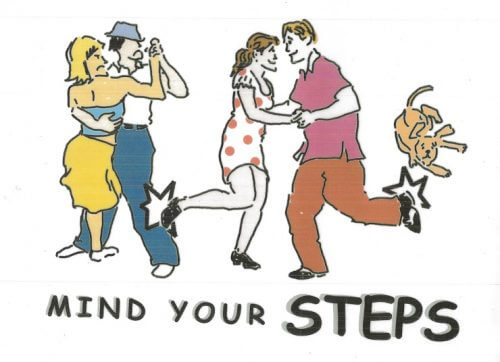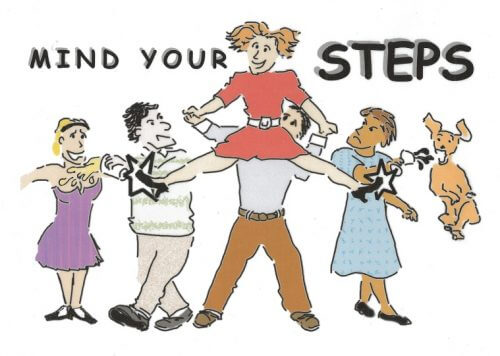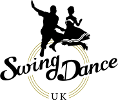Floorcraft & Defensive Dancing Part 1
Somebody recently brought to my attention the need to talk about floorcraft - so here is your ‘how to’ guide to laying the perfect maple wood sprung dance floor – Na just kidding 🙂 - We are talking about social verses anti-social dancing.
The art of dance floor survival particularly related to the Swing & Jive world. It really comes under the heading of dance floor etiquette, but today I want to focus on how to avoid bumps, bruises and the worse like broken bones, to have an enjoyable evening dancing without hobbling off the dance floor in pain and silently cussing the couple next to you & generally how to save ice for your drink rather than your foot.
It’s hard not to experience the occasional bump – the important point is to make them as rare and of as little consequence as possible. We don’t need any extra stress in our lives, let alone extra injuries. Floorcraft starts with recognising potential signs for disaster & diffuse or minimise the situation so that no great harm is done.
I’m sure many of you will recognise the situation when, having been dancing respectfully on the same spot for the last two choruses, suddenly bam! Some leader, kicks you or swings his partner out into your space – and they haven’t even noticed!! Gone are the days (thank goodness) when that wild dancer would be surrounded by a group of his peers doing back Charlestons in an ever decreasing circle until he realises the error of his ways (as I have heard said).
An old dancer once told how he and his friends used to call Saturday night ‘Squares Night’ when they would stand on the balcony looking down at all the less experienced dancers (the ones to come out in masses on a Saturday night) trying to dance on an over-crowded floor.
We have all danced next to (& been) that beginner dancer so absorbed in practising new moves they become oblivious of those around them, or the leader so intent on practising a sequence of steps woe betide any dancer who gets in their path. Although floorcraft should be learnt from day one, it can’t be expected to be perfected right away and I would encourage indulgence towards the beginners who are just learning and don’t yet know yet how to avoid the occasional collision.
Here I would like to raise an important distinction: the worst offender in my eyes is the more experienced dancer who knows (or should know) the concept of spatial awareness & has the technical ability to avoid collisions but is too selfish to match their dancing to the environment. On a crowded dance floor, whilst you are doing your best to contain your dancing, they, in disregard for those around them, are determined to stretch out every limb as far as it goes.

Mind Your Steps 1 Illustration by Arasan Aruliah
So how can we train and spread good floorcraft? I believe two things are necessary: good teaching, and good learning. A good teacher is responsible not just to teach their students how to dance but how to dance socially - in all environments. On the other hand, you can only teach someone who wants to learn and a student will only take in what they want to acquire, therefore it is in the community’s interest to raise awareness of the importance of good floorcraft.
Fred Astaire & Ginger Rodgers had the luxury of a huge stage to themselves and could move freely across it but that’s performance, the social dancers might complain about over crowded floors but I guarantee most will leave if the dance floor looks like it’s going to be empty all night – we get our buzz from being part of a community, when a room full of people all following the rhythm & pulse of the music and yet able to express themselves finding their own personality within the crowd, that is when the magic is created & your dancing will grow.
So in the next issue I will give you three practical concepts from a class I teach called ‘The Art of Defensive Dancing’ which will give you a safer & happier experience on the dance floor: how to be aware of your environment (which needs to be explained from day one of learning to dance), how to take care of your partner and how to protect yourself – and yes follows, you play an equal part in all of them!
Sharing the Lindy love
Swingcerely yours,
Simon
Floorcraft & Defensive Dancing Part 2
Following on from the last issue about floorcraft, here are three practical concepts from a class I teach called ‘The Art of Defensive Dancing’ which will give you a safer & happier experience on the dance floor:
1. Know your environment:
I knew a chap who had been mugged several times, he told me how it happened out of the blue, as he was walking home and I thought how unlucky he was, until I watched him walk away: with his head down & his hands in his pockets, he was sending out the message that he was unaware of his surroundings... whilst we can’t always avoid unfortunate incidents we can do our best to minimise them.
Always check the space around you: the physical space – including the floor & ceiling (I once lifted my partner up into a light fitting - despite the dramatic glass-crashing sound there was luckily no harm done) and the social space, i.e. the people dancing close to you. For example if you find yourself dancing directly behind a couple who you have noticed are into large ‘rock steps’, move your partner (lead or follow) out of harm’s way. Just like other aspects of learning to dance, you will at first need to do this consciously until it becomes automatic. When you can predict where other couples are likely to swing out you know you are becoming a better dancer.
2. Take responsibility:
Once you learn how much space you have to play in, you need to develop skills to condense your own movements & how to move away from trouble spots whilst still dancing. I often get my students to practise a step repeatedly, gradually going from a lead/follow arm at a right angle to an almost outstretched straight arm.
Leaders, you should practise how to send your partner out to different spots on the dance floor - even at the last minute – to avoid potential collisions. Follows, remember you are merely allowing your partner to lead, and sometimes you may have to choose not to follow exactly what your partner asks, if they are sending you even at full speed into another couple you can often step out in a different direction or redirect the energy upwards instead of backwards (pretty cool way to create new variations). In addition to safety, you will find these exercises will improve your dancing in movement control, lead/follow skills and even creativity.

Mind Your Steps 2 Illustration by Arasan Aruliah
3. Build your defense wall
Some dancers seem to always get knocked, bruised & stepped on and others don’t – Why?
On a crowed floor where I know there are a lot of inexperienced or over enthusiastic dancers it is not always sufficient to “dance small”. I feel more confident when my partner is using their free arm as a barrier between her & injury. Like a cat’s whiskers it tells you how much space you have and gives you more time to avoid the more serious bumps, like a spring it can absorb the energy of someone coming towards you and, where needed, can act like a lighthouse telling others to beware.
As a leader when I am dancing and I sense danger, such as a drunk couple next to me, I will often dance my partner off to a better spot and continue dancing with my legs & arms held as a physical barrier & nobody consciously will choose to repeatedly walk into a barrier.
One last thing to remember: if you do bump into somebody, always acknowledge what has just occurred even if it’s not your fault, it costs very little to say sorry, nod or smile.
I hope you found these tips useful and they will help to keep you happy & safe on the dance floor.
Sharing the Lindy love
Swingcerely yours,
Simon
